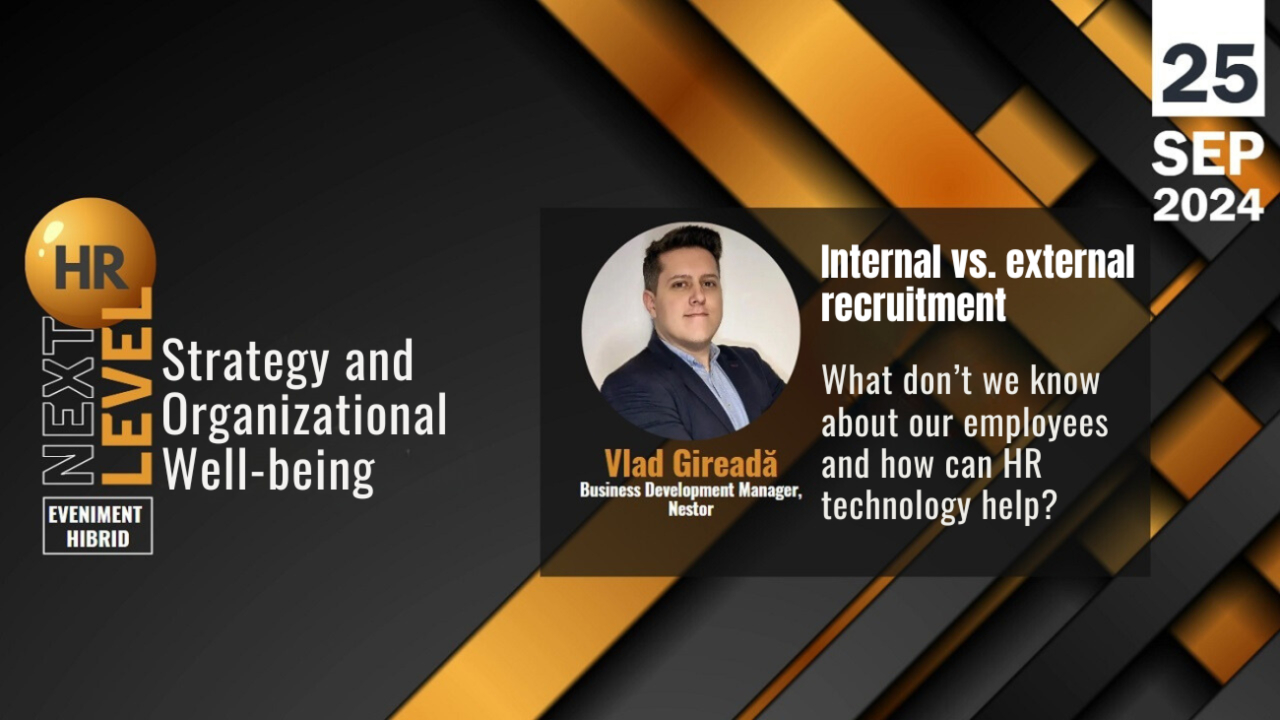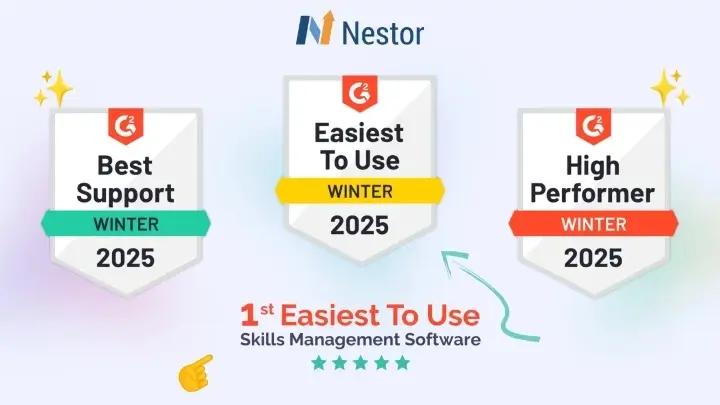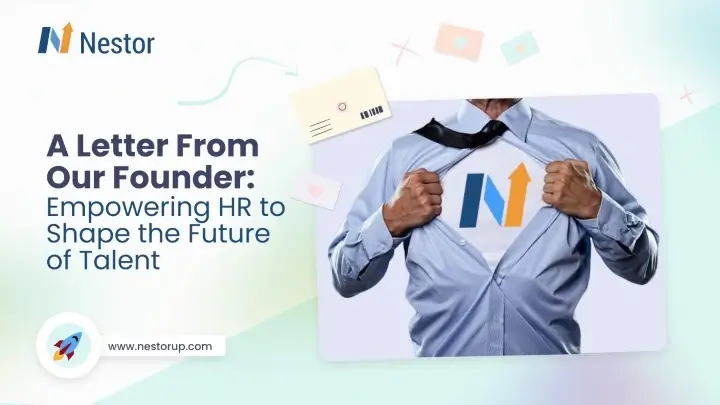Maximize Your Team’s Strengths: Key Takeaways from Vlad Gireadă’s Next Level HR Talk
11 min read

The HR landscape is evolving faster than ever, and staying ahead means embracing new strategies and technologies that drive growth and innovation.
The future of HR is skills-based, and organizations that recognize the hidden potential within their existing teams will be the ones driving success in an increasingly automated world.
Nestor partnered up with Revista Cariere and Revista HR Manager Online for ”Next Level HR” – an event about the bold visions, inspired actions, work and dedication of HR people who lead the organization to success.
During the event, Vlad Gireadă, Business Development Manager at Nestor, shared groundbreaking insights into how HR technology can help organizations shift from traditional talent acquisition to skills-based talent management.
In this article, we’ll break down the key takeaways from Vlad’s speech “External versus internal recruitment: What we don’t know about our employees and how can HR technology help?” and discuss how you can apply these insights to maximize the strengths of your team.
Below, we’ve included a video of Vlad’s full session for those who missed the event or want to dive deeper.
Watch Vlad Gireadă’s Talk on Skills-Based Talent Management:
What will you discover?
- From Talent Acquisition to Talent Access: Why the future is not about hiring more people but about maximizing the potential of the talent you already have.
- Skills-Based Talent Management: How to transition from managing roles to strategically navigating skills in response to rapidly changing market needs.
- HR as a Strategic Partner: Practical insights on how HR can evolve from being a support function to becoming a key driver of business strategy and growth through
From Talent Acquisition to Talent Access
By 2025, 85 million jobs will be automated and half of all global employees will need reskilling due to technological advancements.
As a result, 40% of companies worldwide will need to revise their talent management strategies in line with evolving technology requirements.
What do the statistics of the future tell us?
These statistics do NOT say that change starts in 2025.
They show that the future is happening now. We are already caught in a trend of radical change.
In the face of this wave of change, the usual reaction is to look for external talent, a quick fix to keep up with progress.
What if the solution to unlocking an unprecedented level of innovation is not focused on recruiting external talent, but on discovering untapped potential in the people you already have?
It is in the nature of human beings to do things they already know how to do, to apply skills they already possess to solve tasks with ease and gravitate towards the familiar, hence simple.
We work on tasks for which we already have strong skills and procrastinate on tasks that we are unsure about and do not master so well.
In HR, this tendency translates into a preference for external recruitment.
Why do we prefer external recruitment?
- In the external market we find more data about the workforce than inside the company.
- External candidates come with comprehensive profiles that make decision-making easier.
- Platforms like LinkedIn and detailed resumes provide a clear and transparent picture of individuals, presenting skills, accomplishments, certifications and career trajectory in a neat and consistent package.
This level of detail provides a clear and apparently objective basis for assessing their suitability for the role available.
Why apparently objective?
Well, how many of us haven’t had the experience of hiring someone who seemed perfect in theory, only to discover later that there is no real fit in terms of role and culture?
A similar phenomenon occurs within the company.
Internal evaluation is often based on subjective feedback, inconsistency and bias.
If we take for example the opportunity for career advancement, managers may have limited visibility on the skill set and achievements of their team members, often focusing on their day-to-day performance or recent projects.
This feedback, while valuable, can be influenced by personal opinions, recent interactions or even unconscious biases.
Furthermore, delving into the potential of the current team can give the impression of racing against the clock through a maze.
It requires you to grapple with the complexities of internal dynamics, incomplete or inconsistent information, and engage in the potentially challenging task of uncovering and cultivating hidden talents, a seemingly complex and daunting process.
The result?
We rush to external recruitment because it seems clearer and easier.
But in the rush, we can lose valuable talent who, with the right tools, could unlock innovation in our own team.
Skills-Based Talent Management
What if we looked inside our organization? What if we discovered and capitalized on the talent that already exists?
Skills Navigator
SKILL Navigator is a clear framework that helps us to discover this potential, but also to harness it effectively.
1. Strategize:
- Identify the skills you need today and anticipate future business needs based on where the market is headed.
- Define the strategic competencies needed for the future.
- Set a direction so you are not stuck in the present, but actively preparing the future of the workforce.
2. Know:
- Understand the current skills inventory in the organization.
- Get a clear and comprehensive picture of your employees – their skills, certifications, past performance, and recognitions received.
- Access to a complete picture of internal resources, that allow you to make informed decisions about their development.
3. Identify:
- Identify Skill Gaps
- Anticipate and correct Skill Gaps before they become critical.
- Focus on internal growth, promoting employees with potential and assigning them to strategic roles.
- Improve organizational efficiency, save time and resources by avoiding the constant search for talent outside the company.
4. Leverage:
- Do upskilling and reskilling.
- Personalize the learning journey for each employee, giving them access to relevant courses and educational resources to improve their skills.
5. Learn:
- Build an organizational culture of continuous learning that encourages and supports employees to constantly develop their skills.
- Monitor each employee’s progress, providing constant feedback and identifying new development opportunities.
- Ensure adaptability to rapid changes in the business environment, and increase employee engagement and retention, making employees feel valued and supported in their professional development.
HR as a Strategic Partner
Does SKILL Navigator sound like a time-consuming process?
Well, today’s AI-driven technology allows you to drill down into the skills, certifications, and performance of your employees.
You have skill libraries with thousands of skills and competencies at your fingertips, making it easy to quickly map skills and identify skill gaps that translate into customized upskilling and reskilling plans, automatically collecting and analyzing performance data.
This way, your decisions are based on concrete information, aligning employee development with company goals, anticipating market needs and reducing administrative effort.
What exactly does this mean?
It means you can get a complete and detailed analysis of:
- Who your top performers are
- Who are the most potential talents in your company
- Where there are skills gaps and what is the strategy for filling them
- How you justify a certain budget for learning and development
When you take steps in this direction, you will have clear evidence of performance.
What is the evidence?
The fact that you will have a seat at the table of strategic discussions and become a strong voice in shaping organizational direction.
There’s nothing stopping you from achieving these results right now.
In fact, you can even start with a spreadhseet and any step in that direction will help you more than zero steps. The beginning seems hard, especially when you have to change a well-established paradigm.
But, once you start implementing a clear strategy based on internal talent management data, you’ll find that your efforts pay off in lasting and meaningful benefits.
With access to data about your employees, you can create robust succession planning strategies, identify future leaders, and help employees grow.
Employees feel a higher level of engagement and empowerment when they can clearly see where they are and how they can improve their career.
They see their path clearly defined, they see what skills they need to develop, and they know that the organization is giving them the importance they deserve for their professional development.
Why should you care about technology-based skill management solutions?
Is it really that important to act now?
Well, companies that have invested in competency-based approaches and technologies that facilitate this process:
- Increased employee productivity by 40%
- Increased employee retention by 94%
- Improved employee engagement rates by 30%
- Reduced staff turnover by 25%
These data clearly show that there is no time to wait.
Either we embrace these changes now or risk losing more and more to global competitiveness.
Perhaps some will still stick to the idea that this is “a trend of the future” and that things can change later.
Some of you will wonder:
Still, what’s stopping me from looking for my employees’ skills right on LinkedIn?
But, what does it say about you as an HR specialist if you have to look outside the organization for information about your people internally?
It only indicates that you don’t have the essential data about your team, and so you base your strategy on assumptions or external information.
When you don’t have a solid base of internal data, you run the risk of incomplete strategizing, losing valuable talent, and missing opportunities for growth.
HR technology is expensive; why do this?
Another point some might bring up is investment.
Yes, in the short term, it may seem like a significant investment.
But let’s analyze what it means to hire from the outside:
- The average cost per hire increased by 14% from 2019 to 2023 ($4,129 – $4,700).
- It takes 25 days to fill a vacancy through external recruitment.
- It takes 8 to 26 weeks for a new employee to reach maximum productivity.
- A new employee performs at only 25% of potential in the first 3 months in the new position.
- An externally recruited employee comes in 21% more likely to leave within the first year.
How about the costs of internal recruitment?
- Recruiting internally costs 3 to 5 times less than recruiting externally.
- In-house recruitment can reduce recruitment time by up to 20 days.
- 75% of internally recruited employees are successful in their new position.
- 47% of internally recruited employees stay at least 3 years with the company.
Internal recruiting will not solve all your problems or completely replace external hires. External hiring remains essential especially for team development, entry-level positions or setting up new departments.
However, a balanced strategy focused on developing internal employees can greatly reduce the costs and risks associated with exclusively external recruitment.
It is a strategic approach that allows for better talent management, thereby also improving employee retention.
The technological solutions that exist in HR today are not here to change the way you do things, but to be your partner in achieving your goals.
You don’t have to make a radical change, but you can start gradually, by creating a repertoire of competencies, mapping them and strategically positioning resources.
These steps will enable you to see clearly what skills exist in your team, where the gaps are and how you can plan your future investments in development and training.
In HR, technology is not the enemy; it is the enabler.
It’s not about replacing human input, but amplifying it – giving you, the HR leader, the tools, insights and freedom to be the strategic architect in your organization.
The future is not about managing change tomorrow, but mastering it today.
The future of talent management is not just adaptation; it’s transformation.
Tomorrow’s transformation of your organization starts today – with the right tools, the right insights and the right mindset.
Meet Our Speaker: Vlad Gireadă, Head of Product at Nestor
Vlad Gireadă, our Business Development Manager at Nestor will lead the talk on HR technology. As a visionary in HR technology, Vlad’s passion lies in enabling HR leaders to unlock the hidden potential within their organizations by moving from a traditional talent acquisition model to a skills-based talent management approach.
If you believe in unlocking the full potential of your people and preparing them for a dynamic, agile and competency-based business environment, set up a meeting with Vlad to discover how Nestor can be your strategic partner in internal talent management.
Let’s map the future of work, skill by skill, step by step.










